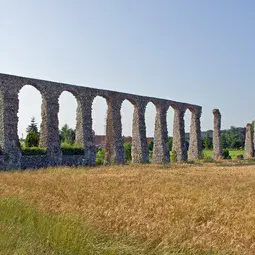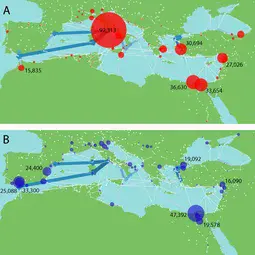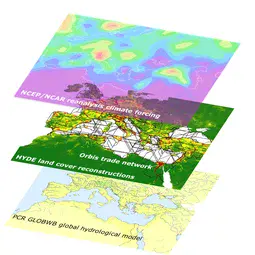Water’s role in the rise and fall of the Roman Empire
Smart agricultural practices and an extensive grain-trade network enabled the Romans to thrive in the water-limited environment of the Mediterranean, a new study shows. But the stable food supply brought about by these measures promoted population growth and urbanisation, pushing the Empire closer to the limits of its food resources. The research, by an international team of hydrologists and Roman historians, is published today in Hydrology and Earth System Sciences, an open access journal of the European Geosciences Union (EGU).
Stretching over three continents and persisting for many centuries, the Roman Empire was home to an estimated 70 million people. In such a vast area ensuring a stable food supply was no easy task, particularly given the variable and arid climate of the Mediterranean region. So how did the Romans maintain reliable food supplies to their cities for centuries under such challenging conditions?
To find out, Brian Dermody, an environmental scientist from Utrecht University, teamed up with hydrologists from the Netherlands and classicists at Stanford University in the US. The researchers wanted to know how the way Romans managed water for agriculture and traded crops contributed to the longevity of their civilisation. They were also curious to find out if these practices played a role in the eventual fall of the Empire.
“We can learn much from investigating how past societies dealt with changes in their environment,” says Dermody. He draws parallels between the Roman civilisation and our own. “For example, the Romans were confronted with managing their water resources in the face of population growth and urbanisation. To ensure the continued growth and stability of their civilisation, they had to guarantee a stable food supply to their cities, many located in water-poor regions.”
In the Hydrology and Earth System Sciences paper, the team focused on determining the water resources required to grow grain, the staple crop of the Roman civilisation, and how these resources were distributed within the Empire. It takes between 1000 and 2000 litres of water to grow one kilo of grain. As Romans traded this crop, they also traded the water needed to produce it – they exchanged virtual water.
The researchers created a virtual water network of the Roman world. “We simulated virtual water trade based on virtual-water-poor regions (urban centres, such as Rome) demanding grain from the nearest virtual-water-rich region (agricultural regions, such as the Nile basin) in the network,” explains Dermody.
The team used a hydrological model to calculate grain yields, which vary depending on factors such as climate and soil type. The authors used reconstructed maps of the Roman landscape and population to estimate where agricultural production and food demand were greatest. They also simulated the trade in grain based on an interactive reconstruction of the Roman transport network, which takes into account the cost of transport depending on factors such as distance and means of transportation.
Their virtual water network indicates that the Romans’ ability to link the different environments of the Mediterranean through trade allowed their civilisation to thrive. “If grain yields were low in a certain region, they could import grain from a different part of the Mediterranean that experienced a surplus. That made them highly resilient to short-term climate variability,” says Dermody.
But the Romans’ innovative water-management practices may also have contributed to their downfall. With trade and irrigation ensuring a stable food supply to cities, populations grew and urbanisation intensified. With more mouths to feed in urban centres, the Romans became even more dependent on trade whilst at the same time the Empire was pushed closer to the limits of their easily accessible food resources. In the long term, these factors eroded their resilience to poor grain yields arising from climate variability.
“We’re confronted with a very similar scenario today. Virtual water trade has enabled rapid population growth and urbanisation since the beginning of the industrial revolution. However, as we move closer to the limits of the planet’s resources, our vulnerability to poor yields arising from climate change increases,” concludes Dermody.
###
Please mention the name of the publication (Hydrology and Earth System Sciences) if reporting on this story and, if reporting online, include a link to the paper (http://www.hydrol-earth-syst-sci.net/18/5025/2014/hess-18-5025-2014.html) or to the journal website (http://www.hydrology-and-earth-system-sciences.net/).
More information
This research is presented in the paper ‘A virtual water network of the Roman world’ published in the EGU open access journal Hydrology and Earth System Sciences on 11 December 2014. The scientific article is available online, free of charge, at http://www.hydrol-earth-syst-sci.net/18/5025/2014/hess-18-5025-2014.html.
Citation: Dermody, B. J., van Beek, R. P. H., Meeks, E., Klein Goldewijk, K., Scheidel, W., van der Velde, Y., Bierkens, M. F. P., Wassen, M. J., and Dekker, S. C.: A virtual water network of the Roman world, Hydrol. Earth Syst. Sci., 18, 5025-5040, doi:10.5194/hess-18-5025-2014, 2014.
The team is composed of B. J. Dermody (Department of Environmental Sciences, Utrecht University), R.P.H. van Beek (Department of Physical Geography, Utrecht University), E. Meeks (Stanford University Library), K. Klein Goldewijk (Department of Environmental Sciences, Utrecht University), W. Scheidel (Department of Classics, Stanford University), Y. van der Velde (Department of Soil, Geography and Landscape, Wageningen University), M. F. P. Bierkens (Department of Physical Geography, Utrecht University), M. J. Wassen (Department of Environmental Sciences, Utrecht University), and S. C. Dekker (Department of Environmental Sciences, Utrecht University).
The European Geosciences Union (EGU) is Europe’s premier geosciences union, dedicated to the pursuit of excellence in the Earth, planetary, and space sciences for the benefit of humanity, worldwide. It is a non-profit interdisciplinary learned association of scientists founded in 2002. The EGU has a current portfolio of 16 diverse scientific journals, which use an innovative open access format, and organises a number of topical meetings, and education and outreach activities. Its annual General Assembly is the largest and most prominent European geosciences event, attracting over 12,000 scientists from all over the world. The meeting’s sessions cover a wide range of topics, including volcanology, planetary exploration, the Earth’s internal structure and atmosphere, climate, energy, and resources. The EGU 2015 General Assembly is taking place in Vienna, Austria, from 12 to 17 April 2015. For information regarding the press centre at the meeting and media registration, please check http://media.egu.eu.
If you wish to receive our press releases via email, please use the Press Release Subscription Form at http://www.egu.eu/news/subscribe/. Subscribed journalists and other members of the media receive EGU press releases under embargo (if applicable) 24 hours in advance of public dissemination.
Contact
Brian Dermody
Department of Environmental Sciences
Utrecht University
Utrecht, the Netherlands
Phone +31 (0) 64 253 7720
Email brianjdermody@gmail.com
Bárbara Ferreira
EGU Media and Communications Manager
Munich, Germany
Phone +49 (0) 89 2180 6703
Email media@egu.eu
Links
- Scientific paper
- Journal – Hydrology and Earth System Sciences
- Read this press release in simplified language, aimed at 7–13 year olds, on our Planet Press site




